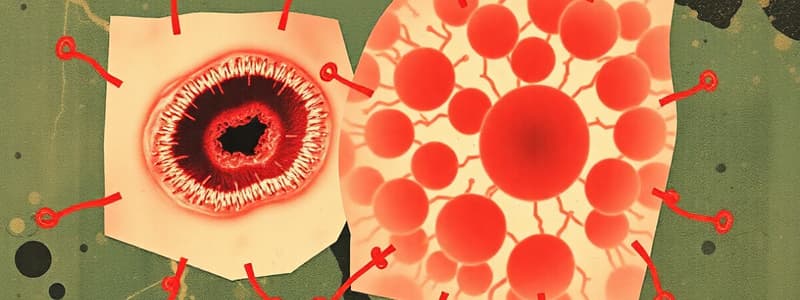Podcast
Questions and Answers
What does atrophy refer to?
What does atrophy refer to?
- Decrease in the size of a body part (correct)
- Increase in the size of a body part
- Injury to a body part
- Inflammation of tissue
Which of the following can cause atrophy?
Which of the following can cause atrophy?
- Increased blood supply
- Reduced workload (correct)
- Excess nutrition
- High metabolic activity
Atrophy can be a normal process as a result of which of the following?
Atrophy can be a normal process as a result of which of the following?
- Injury during exercise
- Excessive physical activity
- Aging (correct)
- Chronic infection
What happens to the muscles of the uterus after delivery?
What happens to the muscles of the uterus after delivery?
Which of the following is NOT a cause of atrophy?
Which of the following is NOT a cause of atrophy?
What is the primary characteristic of hypertrophy?
What is the primary characteristic of hypertrophy?
In hypertrophy, what primarily causes the increase in cellular size?
In hypertrophy, what primarily causes the increase in cellular size?
Which of the following is an example of hypertrophy?
Which of the following is an example of hypertrophy?
What is a potential application of understanding hypertrophy?
What is a potential application of understanding hypertrophy?
Which statement about the size of the pregnant uterus is correct?
Which statement about the size of the pregnant uterus is correct?
What characterizes hyperplasia?
What characterizes hyperplasia?
In which situation does hyperplasia typically occur?
In which situation does hyperplasia typically occur?
What is the main difference between hyperplasia and hypertrophy?
What is the main difference between hyperplasia and hypertrophy?
Which of the following could be an example of hyperplasia?
Which of the following could be an example of hyperplasia?
Which correct statement about hyperplasia and hypertrophy is true?
Which correct statement about hyperplasia and hypertrophy is true?
What typically triggers hyperplasia?
What typically triggers hyperplasia?
How does hyperplasia relate to dysfunctional cells?
How does hyperplasia relate to dysfunctional cells?
Which row in the diagram illustrates hyperplasia?
Which row in the diagram illustrates hyperplasia?
What is a potential effect of hyperplasia on an organ?
What is a potential effect of hyperplasia on an organ?
Flashcards are hidden until you start studying
Study Notes
Atrophy
- Refers to a decrease in the size of a body part, cell, organ, or tissue.
- Occurs due to a decrease in cell size.
- Can be a normal process due to aging or reduced workload, use, metabolic activity, blood supply, nutrition, or disease.
- Example: Muscles of the uterus atrophy after delivery.
Hypertrophy
- "Excessive growth" in size.
- Cells and tissues increase in size, causing an increase in the size of their respective organs.
- Mechanism is often based on increased demand.
- This is caused by an increased accumulation of protein in the cellular components.
- Example: The pregnant uterus increases in size due to cell enlargement.
Hyperplasia
- "Excessive growth" in numbers of cells.
- An increase in the number of cells due to a higher rate of cell division.
- Can be a response to severe and prolonged injury, hormonal stimulation, or a compensatory mechanism for dysfunctional cells.
- Example: The pregnant uterus increases in size due to a higher number of cells.
Metaplasia
- A reversible process where one cell type converts to another cell type in response to environmental changes.
- Example: Cells in the vaginal lining can convert from glandular to squamous due to changes in vaginal pH.
Dysplasia
- Abnormal changes in the shape, size, and organization of mature cells.
- Typically associated with cancerous or pre-cancerous growth.
- Can be reversed by removing the inciting stimulus or removing the diseased organ.
- Example: Uterine cervix cells can become dysplastic due to HPV.
- Smoking is a stimulus for dysplasia in the lungs and is considered a co-carcinogen.
Studying That Suits You
Use AI to generate personalized quizzes and flashcards to suit your learning preferences.




